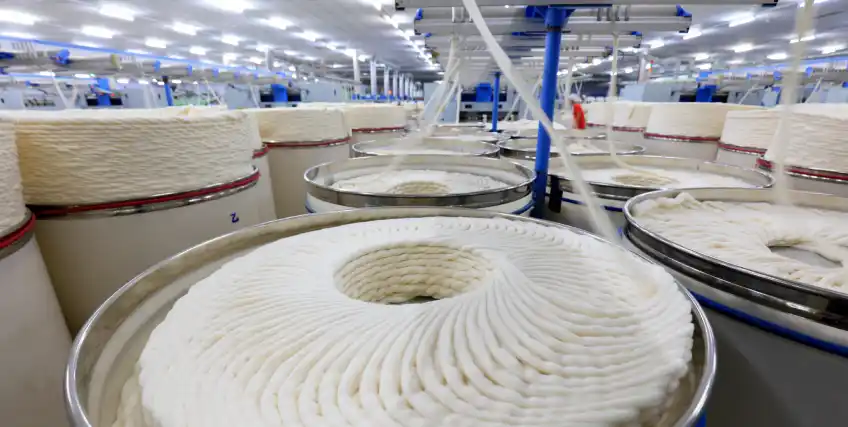Secure Apparel & Textile Financing
Without Slowing Cash Flow
Looking for Business Financing?
Apply now for flexible business financing. Biz2Credit offers term loans, revenue-based financing, lines of credit, and commercial real estate loans to qualified businesses.
Set up a Biz2Credit account and apply for business financing
The apparel industry powers everything from everyday wear to runway collections. But behind every well-stitched garment is a strong financial backbone. Whether you run a small garment unit or a large-scale textile manufacturer, cash isn’t just helpful; it’s essential.
Apparel & textile financing is more than just borrowed capital. It helps cover costs like raw materials, equipment, staffing, and even purchase orders. As demand from retailers, distributors, and wholesalers fluctuates, reliable access to funds can keep operations going smoothly.
From sourcing fabrics to shipping finished goods, each step has a price tag. Factors like seasonal demand, rising interest rates, and global supply chain delays also impact margins. And with a growing focus on sustainability, many apparel businesses need capital to reduce emissions or switch to eco-friendly processes.
Whether you're investing in textile equipment financing, improving working capital, or covering large orders, having the right financing options gives you breathing room. In today’s competitive market, the lack of liquidity can stall growth, even for established textile companies.
U.S. textile and apparel manufacturers have unique financial needs. Meeting them requires practical financial solutions, especially as the industry adapts to fast trends, overseas competition, and tighter lead times.
When to Seek Financing for Apparel & Textile Businesses
Textile and apparel operations face constant cash needs. Whether you're scaling up or smoothing daily costs, the right apparel & textile financing helps you stay on track.
1. Upgrading Equipment
New looms, dye machines, and cutters don’t come cheap. Investing in upgraded gear boosts speed and product quality. Textile equipment financing makes this achievable without draining reserves. Many textile businesses use equipment loans to stay efficient and meet seasonal demand. The right gear reduces downtime and helps maintain supply contracts with retailers or distributors. Equipment upgrades also support efforts to reduce emissions and cut energy costs in the long run.
2. Covering Payroll During Peak Production
Large orders often demand overtime or seasonal labor. Whether you're producing for wholesalers or fashion retailers, labor expenses stack up fast. Apparel & textile financing offers the required working capital to keep your team paid and morale steady. This is critical during periods where payments from retailers are delayed. Without a cash buffer, missed payroll can stop production lines and damage workforce trust.
3. Buying Raw Materials in Bulk
Cotton, wool, synthetic fibers – such type of raw inputs are often cheaper when bought in bulk. But upfront purchases require quick capital. A short-term loan or line of credit lets you lock in at low pricing and ensure inventory availability. This helps mitigate supply chain risks and meet tight client deadlines. Apparel companies that rely on imports also use apparel & textile financing to handle international supplier costs and logistics.
4. Fulfilling Large Purchase Orders
Big-box stores and global retailers often place massive orders with strict deadlines. But fulfilling them can stretch your budget thin. Purchase order financing gives apparel manufacturers the liquidity needed to pay vendors upfront and manage production costs. It helps turn potential deals into real profit without disrupting other commitments. This approach also reduces strain on your main credit facility.
5. Adopting Sustainable Manufacturing Practices
The fashion sector is under pressure to reduce waste and embrace sustainability. Solar panels, water recycling, and low-impact dyes need capital. Through apparel & textile financing, companies can fund green upgrades without risking their cash flow. Investing in eco-practices also opens new doors with climate-conscious retailers and importers. Over time, it cuts operational costs and future-proofs the business.
Types of Apparel & Textile Financing You Can Explore
Funding needs vary depending on your business model, revenue cycle, and growth plans. Here's a look at practical apparel & textile financing options used by U.S. manufacturers.
1. Term Loans
These are fixed-sum loans repaid over a set period. They’re ideal for equipment upgrades, warehouse expansions, or fulfilling large supply contracts. Many textile companies use term loans for long-term investments. With predictable payments, they offer clarity on planning. Interest rates depend on business credit, industry risks, and use of funds. They help stabilize cash flow while building business credit over time.
2. Lines of Credit
A line of credit offers flexible access to capital when you need it. You only pay interest on the amount used. This suits textile businesses that face fluctuating expenses due to seasonal demand or raw material cost hikes. It helps manage shortfalls without needing a full loan. Apparel businesses often tap into these during procurement or to bridge gaps in payments from retailers.
3. Equipment Financing
This option is purpose-built for buying or leasing machinery. Whether it’s looms, laser cutters, or dye units, textile equipment financing lets you secure tools without large upfront payments. The equipment itself acts as collateral. This is a popular choice for growing garment producers looking to scale up. It also supports innovation like automated sorting and eco-friendly textile processors.
4. Invoice Factoring
If you’re waiting on payments from retailers or distributors, invoice factoring helps unlock cash tied up in receivables. A financial provider advances a portion of the invoice value so your operations keep moving. Many textile manufacturers use this to manage payroll, rent, or vendor payments without delays. It helps keep liquidity flowing without piling on new debt.
5. Purchase Order Financing
PO financing lets you accept large orders without using your own cash. A lender pays your suppliers directly, then collects when your customer pays. This is useful for smaller or mid-sized apparel manufacturers trying to fulfill growing contracts. It avoids overextending your resources and preserves your working capital for day-to-day needs.
What Lenders Look for Before Approving Textile Industry Loans
Securing apparel & textile financing isn’t just about asking. You’ll need to prove your business is fund-worthy. Here’s what most lenders want to see.
1. Detailed Financials
Lenders want to see your numbers - clean and consistent. This includes tax returns, profit and loss statements, and balance sheets. Solid financials prove that your business manages its cash flow and can handle debt.
2. Strong Revenue and Growth Potential
If your revenue has grown over time or shows seasonal strength, that’s a win. Lenders want assurance you’ll repay on time. Textile firms that serve multiple retailers, maintain solid purchase volumes, or show repeat orders tend to attract better terms.
3. Credit History and Score
Both personal and business credit scores matter. A poor score can spike interest rates or lead to rejections. Most financial services providers require at least a 600+ score. Apparel businesses should keep credit utilization low and resolve any past issues before applying.
4. Solid Supply Chain Management
A resilient supply chain is critical. Lenders assess vendor contracts, lead times, and how well you manage disruptions. Businesses using diversified suppliers or managing raw materials through systems gain extra points.
5. Clear Use of Funds
Be precise. If you’re using the loan for textile equipment financing, show quotes. If it’s for payroll or invoice factoring, back it up with numbers. Vague answers won’t help your case. The more specific you are, the easier it is for the lender to say yes.
Pros and Cons of Apparel & Textile Financing
Apparel & textile financing can push your business forward but it’s not risk-free. Here’s a look at the benefits and trade-offs you need to weigh.
Pros of Apparel & Textile Financing
1. Fuels Fast Growth
When demand rises or you land a big order, you may not have the working capital on hand to deliver. With financing, you can accept larger contracts, stock more raw materials, or ramp up production without delay. This gives apparel manufacturers the agility to compete with global providers and keep retailers happy without stretching your finances too thin.
2. Keeps Operations Running Smoothly
Unexpected costs can strain your cash reserves. Loans or lines of credit offer flexibility to cover payroll, utilities, and vendor payments without interruptions. A steady cash stream keeps the business from stalling, especially when accounts receivable is delayed. This is crucial for textile businesses that rely on long production cycles and payment timelines.
3. Builds Credit and Business Value
Using financial solutions responsibly helps build your credit profile. Over time, it opens doors to better interest rates, larger funding amounts, and more favorable terms. It also strengthens your reputation with suppliers, lenders, and potential partners. That kind of financial track record adds long-term value to your apparel business.
Cons of Apparel & Textile Financing
1. Increases Debt Load
Borrowing comes with repayment obligations. If your cash flow isn’t steady, loan payments can quickly become a burden. For textile companies facing seasonal slumps or order cancellations, debt repayment can pressure operations. Mismanaging loans can snowball into overdue bills, penalties, or even asset loss.
2. Some Financing Options Are Costly
Certain products like invoice factoring or short-term advances may carry higher fees or APRs. These can cut into your margins, especially if your production costs are already high. Without careful planning, borrowing can eat into profits instead of fueling growth. Always compare interest rates and terms before deciding.
3. Requires Extensive Documentation
Loan applications take time. You’ll need detailed records, from bank statements to supplier contracts. For busy apparel companies, gathering and updating these files can be tedious. Missing documents or incomplete applications delay approval and risk rejection, even when the business is fund-worthy.
Funding Needs by Apparel & Textile Business Type
Not all apparel companies operate the same way. Your funding needs can shift based on your business model, products, and supply volume. Here’s how it breaks down.
1. Small Fashion Labels
Independent brands often operate with thin margins and high upfront costs. From fabric sourcing to e-commerce logistics, everything hits early. Fashion industry financing helps cover collection launches, social media campaigns, and digital storefronts. Smaller labels may use lines of credit or invoice factoring to keep pace with fast trends and pay vendors on time. These flexible options let them focus on growth instead of scrambling for capital.
2. Fabric Manufacturers
If you’re producing at scale, your cost structure is different. You’re likely investing in dyeing systems, automated looms, and bulk raw materials. Fabric manufacturers financing supports these capital-heavy operations. Many turn to equipment financing or asset-based lending to upgrade machinery or manage large-volume orders. Strong vendor relationships and a steady supply chain are key to securing funding.
3. Export-Focused Apparel Producers
Selling internationally means dealing with freight, insurance, customs, and long payment windows. That ties up working capital fast. Exporters often rely on purchase order financing and accounts receivable loans to stay afloat while waiting on global clients. It’s also common to need help covering compliance costs like quality audits and country-specific certifications. Funding ensures these producers can ship on time and scale exports.
Common Mistakes to Avoid During the Loan Process
Applying for apparel & textile financing isn’t hard, but small errors can cost you a lot. Here are mistakes that stop businesses from getting the funding they need.
1. Overestimating Revenue and Underestimating Costs
Lenders look for accuracy. Overstating income or ignoring overhead gives the impression of poor planning. When your real costs, such as rent, labor, or raw materials, don’t match projections, lenders will pull back. It’s better to be conservative and precise. A solid application reflects a clear understanding of your business model and future cash needs.
2. Ignoring Financing Comparisons
Grabbing the first offer without shopping around can hurt. Some financing options have hidden fees or high interest rates. Comparing lenders helps you spot better terms. Look at loan duration, rate structure, and penalties. Understanding the difference between bank loans, credit facilities, and factoring can save your apparel business thousands in the long run.
3. Not Having a Defined Loan Purpose
Lenders want to know exactly how you’ll use the money. Saying “for operations” is too vague. Instead, say “to purchase embroidery equipment” or “to finance a $200K purchase order.” This signals intent and builds trust. The clearer your use case, the more confident lenders are that you’ll repay it.
4. Submitting Incomplete or Disorganized Documents
Missing paperwork slows down processing, or worse, leads to rejection. Loan applications often require tax returns, bank statements, supplier contracts, and proof of incorporation. If you run a textile company and can’t show a consistent cash flow, lenders see red flags. Clean, complete files boost your credibility and speed up approvals.
Trusted by Thousands of Small Business Owners in America.**
Simply because we get what you go through to build a business you believe in.
**Disclaimer: All stories are real, as told by real business owners. Customers do not receive monetary compensation for telling their stories.
From One Entrepreneur to Another: We Get You
We understand what's behind building a business you believe in.
All stories are real, as told by real business owners. Customers do not receive monetary compensation for telling their stories.



Articles on Loans for Textile & Apparel Manufacturers
The Role of Purchase Order Financing in the Apparel Industry
The fashion industry moves fast. For apparel brands, meeting demand means having cash available, right when it’s needed. However...
How to Secure Funding for Your Apparel Manufacturing Business
To start an apparel manufacturing business in the U.S. today demands creativity and craftmanship. Behind every great fashion...
Popular Apparel Financing Options for Small Fashion Brands
Behind every successful small fashion brand lies more than just creativity, taking smart financial decisions plays a huge role.
Frequently Asked Questions on Apparel & Textile Financing
1. What is apparel & textile financing?
It’s business funding designed for U.S. textile manufacturers, apparel companies, and fashion producers. It supports costs like equipment, raw materials, payroll, and shipping. Loans can help stabilize cash flow and meet large orders.
2. Can startups in the textile space qualify for financing?
It depends on the lender, but it’s tougher. New businesses may need strong personal credit or collateral. Some lenders offer working capital or PO financing to newer apparel businesses with confirmed orders.
3. How is equipment financing different from a term loan?
Equipment financing is loaned specifically for machinery or tools. The equipment itself acts as collateral. Term loans are more general-purpose and aren’t tied to one asset.
4. Are there financing options for international exports?
Exporters often use accounts receivable loans or purchase order financing to cover upfront costs while waiting for payment from overseas importers or distributors.
5. Can I get financing with slow-paying retail clients?
Many apparel manufacturers use invoice factoring to unlock funds from unpaid invoices. It helps maintain liquidity and meet operating expenses while waiting for payments.
Frequent searches leading to this page
Term Loans are made by Itria Ventures LLC or Cross River Bank, Member FDIC. This is not a deposit product. California residents: Itria Ventures LLC is licensed by the Department of Financial Protection and Innovation. Loans are made or arranged pursuant to California Financing Law License # 60DBO-35839



